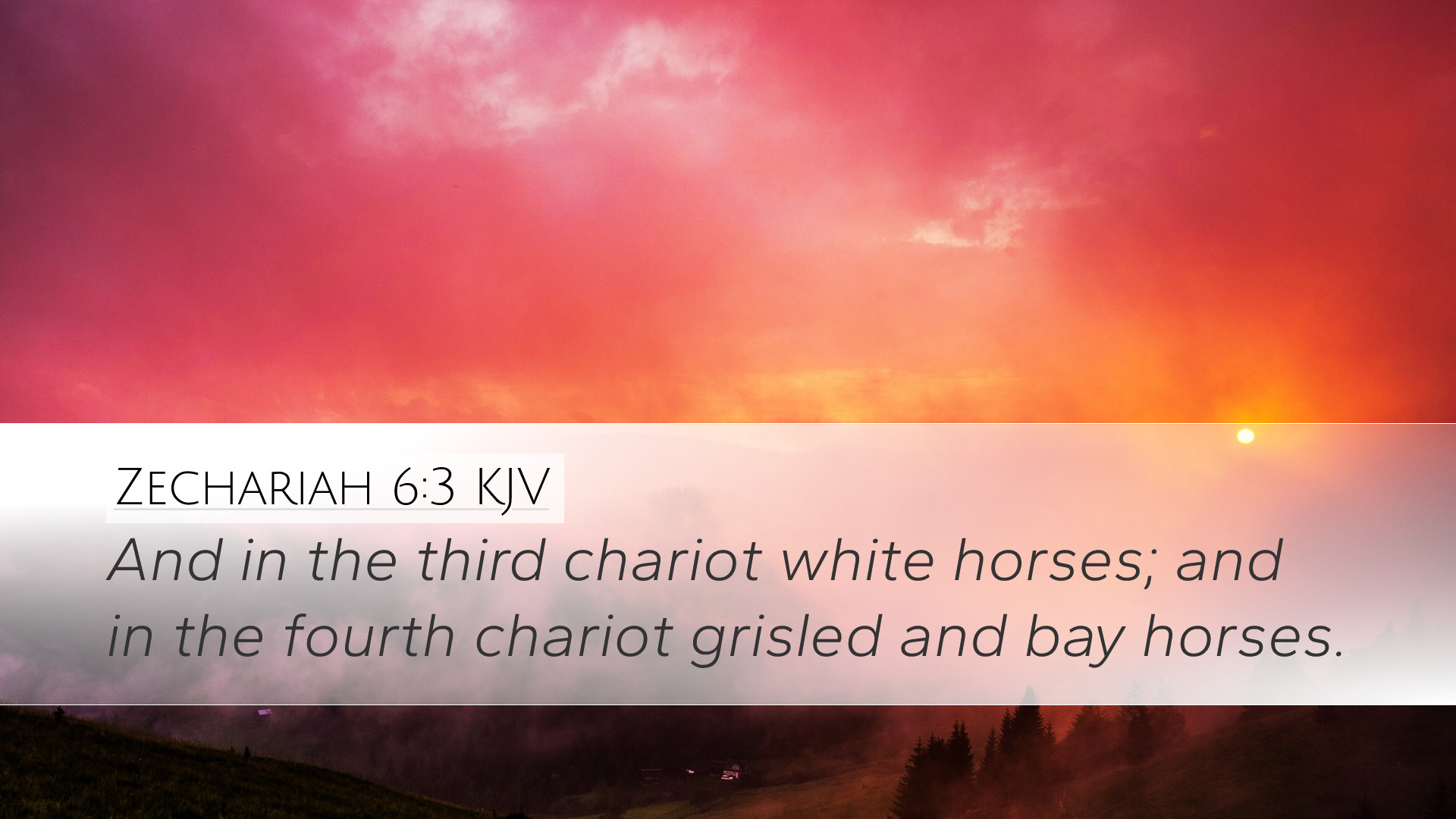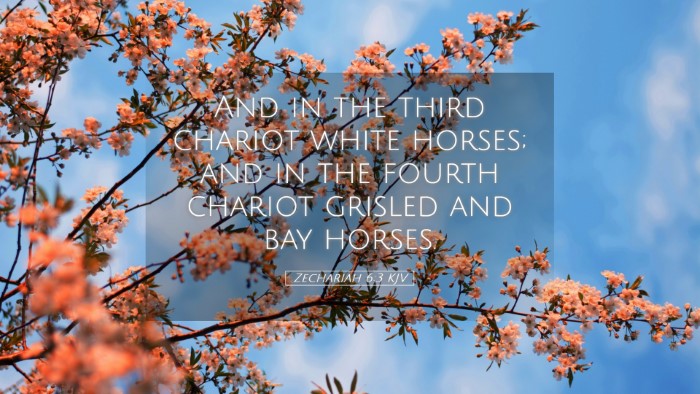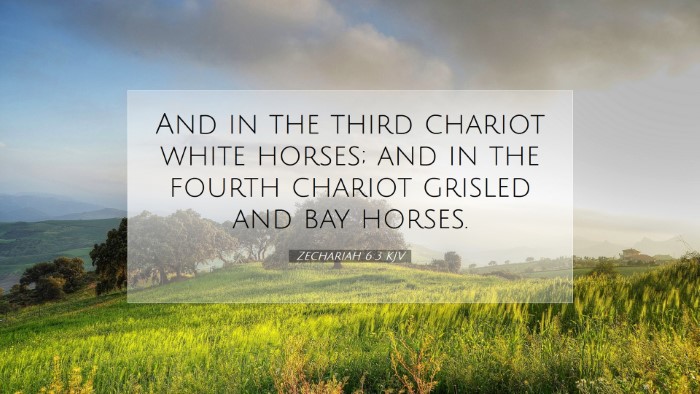Old Testament
Genesis Exodus Leviticus Numbers Deuteronomy Joshua Judges Ruth 1 Samuel 2 Samuel 1 Kings 2 Kings 1 Chronicles 2 Chronicles Ezra Nehemiah Esther Job Psalms Proverbs Ecclesiastes Song of Solomon Isaiah Jeremiah Lamentations Ezekiel Daniel Hosea Joel Amos Obadiah Jonah Micah Nahum Habakkuk Zephaniah Haggai Zechariah MalachiZechariah 6:3
Zechariah 6:3 KJV
And in the third chariot white horses; and in the fourth chariot grisled and bay horses.
Zechariah 6:3 Bible Commentary
Commentary on Zechariah 6:3
Verse Context: Zechariah 6:3 states, “And in the second chariot were black horses; and in the third chariot white horses; and in the fourth chariot grizzled and bay horses.” This verse is part of a larger prophetic vision presented to Zechariah regarding the future of God's people and the coming judgment on the nations.
General Overview
In this vision, Zechariah witnesses a procession of chariots drawn by horses of different colors. Each color and the type of horse can represent different attributes of God's dealings with the nations and His sovereignty in governance. The imagery of the horses and chariots delivers a profound message about divine judgment and providence.
Insights from Public Domain Commentaries
Matthew Henry's Commentary
Matthew Henry provides an intricate perspective on Zechariah 6:3 by emphasizing the symbolic nature of the chariots and horses. He interprets these elements as representing God’s control over the affairs of nations. Henry points out that:
- The black horses symbolize war and famine—condemning evil and judgment upon those nations who oppose God's will.
- The white horses represent victories and divine favor, indicating God's triumph over evil.
- The grizzled and bay horses illustrate the complexities of God's plans, reflecting both mercy and judgment.
Henry highlights that these colors are not arbitrary; rather, they correspond to God's purposes in executing His will on earth, presenting a vivid picture of the dynamic between divine judgment and grace.
Albert Barnes' Notes
Albert Barnes elaborates on the prophetic nature of the vision, focusing on the significance of the colors of the horses. He clarifies that:
- The black horses are indicative of the dark consequences that come from sin and disobedience, projecting a time of distress.
- The white horses, in stark contrast, represent purity, hope, and the ultimate victory of good over evil.
- The grizzled (or spotted) and bay horses serve as a reminder of the mixed responses of humanity towards God’s interventions—reflecting a chaotic world awaiting divine order.
Barnes emphasizes that the imagery must be understood within the larger context of God's plan for restoration, assuring God's people of His continued oversight and intervention in worldly affairs.
Adam Clarke's Commentary
Adam Clarke takes a slightly different angle by focusing on the function of the chariots as agents of God's will. Clarke notes:
- The chariots are symbols of God's messages to the world, dispatched to fulfill His purposes among the nations.
- The varying horse colors represent distinct missions: some bring judgment, while others convey grace and restoration.
- The portrayal of chariots in motion suggests an active God, involved in the human experience, moving quickly to achieve His plans.
According to Clarke, this passage reinforces the idea that God is not distant, but rather engaged in the unfolding narrative of human history, directing events for the ultimate good of His people.
Theological Implications
The various interpretations from Henry, Barnes, and Clarke collectively highlight several theological implications stemming from Zechariah 6:3:
- Sovereignty of God: The chariots symbolize God's control over history and His power to execute judgment and deliverance.
- Divine Judgment: The colors indicate the seriousness of sin and its repercussions, assuring readers that God's justice will ultimately prevail.
- Hope in Restoration: The white horses represent the hope that God provides through His redemptive work in the world, affirming that while judgment may come, restoration is also possible.
Applications for Pastors and Theologians
Pastors, students, and theologians can extract profound lessons from Zechariah 6:3 to apply in their ministry and study:
- Preaching on God’s Sovereignty: Emphasizing God's dominion can inspire confidence in His providential care, especially during turbulent times.
- Understanding Judgment and Grace: Teaching about the balance of judgment alongside grace can lead to healthy reflections on sin and redemption within the church community.
- Encouraging Hope: This passage offers reassurance that despite chaotic seasons, God is moving with purpose toward ultimate restoration.
- The Role of Prophecy: Engaging with prophetic literature encourages believers to remain vigilant and active in their faith, fostering a deeper connection with Scripture.
Conclusion
Zechariah 6:3 serves as a rich source of imagery reflecting God's active role in history, the inevitability of divine judgment, and the promise of restoration. The insights gathered from notable biblical commentaries provide a well-rounded understanding that pastors and theologians can utilize to deepen their teaching and spiritual practices. The vivid imagery of the chariots and horses calls believers to recognize both the seriousness of sin and the hopefulness of God's ultimate victory through Christ.


